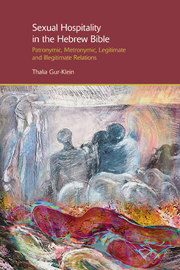 Sexual Hospitality in the Hebrew Bible
Sexual Hospitality in the Hebrew Bible So far we have discussed conjugal patterns associated with baal marriage of dominion. Such conjugal forms transfer a woman from her natal kin to her husband's abode, which falls under exogamous marriage. The husband pays an appropriate purchase price for a chief-wife, a concubine or a slave-wife respectively; such marriage is affiliated with bonds of dominion that inaugurate the woman to a husband's household, kin and tribe; divorce is a husband's prerogative only; and generally baal marriage regards offspring as belonging to the husband's family line. While a woman relinquishes her asset rights to her natal family land on her exogamous marriage as she leaves her natal family, he has no direct asset rights to her husband's land; she may enjoy it through her offspring – counted as her husband's heirs, they are her eventual providers in her widowhood.
However, alternative forms of marriage counter balance baal marriage of dominion. Such conjugal bonds comprise rules and laws that divert from those of baal marriage by allowing or obliging the woman to remain residing with her kin after her marriage. Two kinds of marriage enable a woman to remain with her kin. One type sees the woman marry one of her kin, with the eventual consequence that both partners remain on their tribal land with their mutual kin and their offspring are considered to be of joint descent. Such a marriage is entitled endogamy (Robertson Smith [1885] 1907: 74, 101).
To save this book to your Kindle, first ensure [email protected] is added to your Approved Personal Document E-mail List under your Personal Document Settings on the Manage Your Content and Devices page of your Amazon account. Then enter the ‘name’ part of your Kindle email address below. Find out more about saving to your Kindle.
Note you can select to save to either the @free.kindle.com or @kindle.com variations. ‘@free.kindle.com’ emails are free but can only be saved to your device when it is connected to wi-fi. ‘@kindle.com’ emails can be delivered even when you are not connected to wi-fi, but note that service fees apply.
Find out more about the Kindle Personal Document Service.
To save content items to your account, please confirm that you agree to abide by our usage policies. If this is the first time you use this feature, you will be asked to authorise Cambridge Core to connect with your account. Find out more about saving content to Dropbox.
To save content items to your account, please confirm that you agree to abide by our usage policies. If this is the first time you use this feature, you will be asked to authorise Cambridge Core to connect with your account. Find out more about saving content to Google Drive.